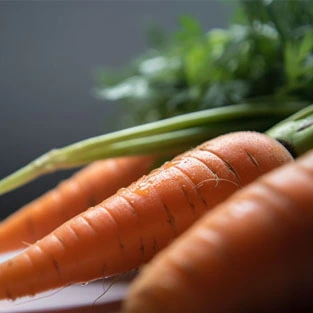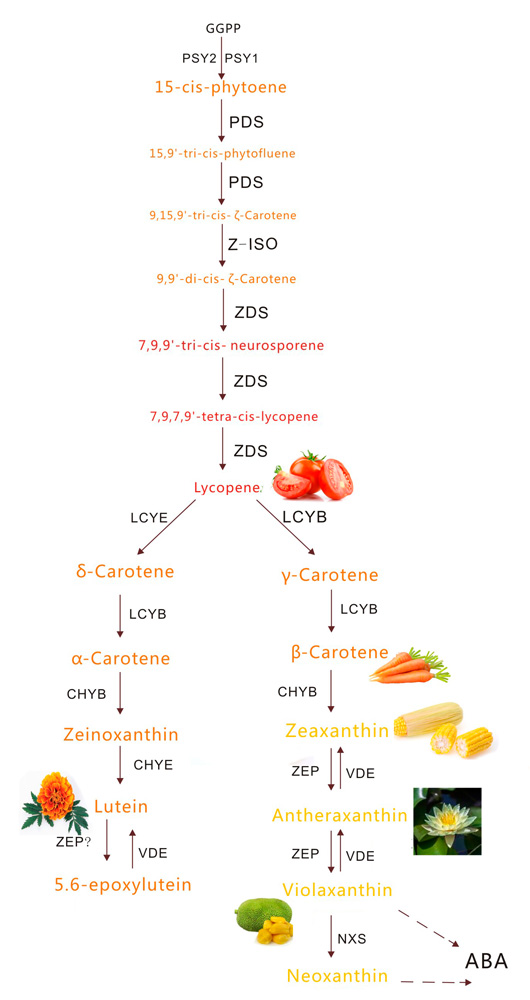

Carotenoids serve various essential functions in plants. Apart from imparting diverse colors, they act as antenna pigments vital for photosynthesis, play crucial roles as photoprotective molecules, and serve as precursors for the synthesis of plant hormones.
Carotenoids have significant implications for human health. They are important for the synthesis of vitamin A and have antioxidative properties, which can reduce the risk of cardiovascular diseases and various types of cancer.
MetwareBio has developed a sensitive detection method that accurately quantifies 68 carotenoids. This assay is perfect for studying pigment development in plants, food nutrition and antioxidant properties, and the regulation of carotenoid biosynthesis. MetwareBio has collaborated on over 1000 projects involving 300+ species in plant research. Speak to us regarding your plant research and how metabolomics can be applied.

Quantitative accuracy: Quantification using external standard method, linear standard curve > 0.99.
Broad coverage: 68 carotenoids, including lycopene, β-carotene, octahydrolycopene, lutein, and others. Contact us for a full list.
High sensitivity: Detection at ng/mL level.
Rich experience: Participated on more than 1000 projects covering 300+ species and published in Nature Communications, The Plant Journal, Food Chemistry and others.
NO. | Compounds | NO. | Compounds | NO. | Compounds |
1 | α-carotene | 24 | rubixanthin laurate | 47 | zeaxanthin-myristate-palmitate |
2 | lycopene | 25 | rubixanthin myristate | 48 | zeaxanthin dipalmitate |
3 | γ-carotene | 26 | rubixanthin palmitate | 49 | zeaxanthin-palmitate-stearate |
4 | β-carotene | 27 | violaxanthin dibutyrate | 50 | zeaxanthin-oleate-palmitate |
5 | phytofluene | 28 | violaxanthin laurate | 51 | β-cryptoxanthin laurate |
6 | (E/Z)-phytoene | 29 | violaxanthin myristate | 52 | β-cryptoxanthin myristate |
7 | ε-carotene | 30 | violaxanthin palmitate | 53 | β-cryptoxanthin palmitate |
8 | antheraxanthin dipalmitate | 31 | violaxanthin palmitoleate | 54 | β-cryptoxanthin oleate |
9 | lutein caprate | 32 | violaxanthin dilaurate | 55 | antheraxanthin |
10 | lutein laurate | 33 | violaxanthin-myristate-caprate | 56 | zeaxanthin |
11 | lutein myristate | 34 | violaxanthin-myristate-laurate | 57 | violaxanthin |
12 | lutein palmitate | 35 | violaxanthin dimyristate | 58 | neoxanthin |
13 | lutein stearate | 36 | violaxanthin-myristate-palmitate | 59 | lutein |
14 | 5,6epoxy-luttein dilaurate | 37 | violaxanthin dipalmitate | 60 | β-cryptoxanthin |
15 | lutein dilaurate | 38 | violaxanthin-myristate-oleate | 61 | astaxanthin |
16 | 5,6epoxy-lutein-caprate-palmitate | 39 | violaxanthin dioleate | 62 | 8'-apo-beta-carotenal |
17 | lutein dimyristate | 40 | zeaxanthin myristoleate | 63 | capsanthin |
18 | lutein dipalmitate | 41 | zeaxanthin palmitate | 64 | α-cryptoxanthin |
19 | lutein distearate | 42 | zeaxanthin-caprate-laurate | 65 | capsorubin |
20 | lutein dioleate | 43 | zeaxanthin dilaurate | 66 | canthaxanthin |
21 | lutein oleate | 44 | zeaxanthin-laurate-myristate | 67 | echinenone |
22 | neochrome palmitate | 45 | zeaxanthin dimyristate | 68 | β-citraurin |
23 | rubixanthin caprate | 46 | zeaxanthin-laurate-palmitate |
Analysis Method and Instrumentation: LC-MS/MS(SCEX Triple Quad 6500+)
1. Molecular mechanism study on coloring of fruits, vegetables, and flowers
Li et al. Mol Plant. 2022; 15(8):1367-1383.
2. Study on the regulation of carotenoid synthesis
Yang et al., Hortic Res. 2021;8(1):85.
3. Molecular mechanism study on quality of fruits, vegetables
Carotenoids modulate kernel texture in maize by influencing amyloplast envelope integrity.
Wang et al., 2020.Nat Commun. 2020; 11(1):5346.
Sample type | Minimum Sample | Minimum Risk Sample Size | Biological Repetition | |
Plant tissues | Stems, buds, nodes, leaves, flowers, fruits, roots, healing tissues | 600mg | 300mg | 3-6 |

Please submit a detailed description of your project. We will provide you with a customized project plan metabolomics services to meet your research requests. You can also send emails directly to support-global@metwarebio.com for inquiries.